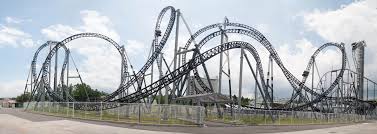When I first started writing middle grade novels, I was a total pantser. I’d get an idea, mull it around for a bit, jot down some notes, then plunge in without really having an idea where my story would go. It was a fun ride full of surprises, and I enjoyed every minute of it. I loved how my characters took over the story once I got to know them better, and couldn’t wait to see how they’d get out of all the situations they stumbled into. I was amazed at the gems that popped up! But then I realized how much muck I had to dig through. I didn’t have a full story arc. It was more like the fast ups, downs, twists, turns, and upside-down loops of a roller coaster. I’ve lost count of how many major rounds of revisions it took to turn my roller coaster rides into fully fleshed out story arcs.
I thought about outlining. For a minute. It felt too restricting. I didn’t want to know all the major details about my stories in advance. But I also wanted to have stronger structures to my novels. So now, I’m somewhere between a plotter and a pantser.
Before leaping into a new novel, I still do my typical brainstorming (which can last for a brief period of time to several months or even longer if I’m working on another project but can’t get ideas for a new one out of my head). I jot down any possibilities that hit and cross out ones that don’t look like they’ll work. But now I’ve added or enhanced a lot of other techniques, too.
- My character sketches are much more in depth. I used to jot down a few ideas, then change a lot of it as I wrote and got to know my characters better. It feels strange trying to know so much about my characters before diving into their stories (especially after finishing a novel where I know my characters inside and out), but the more I brainstorm the story and work on the overall plot ahead of time, the more my initial character sketches work throughout the book (although it’s rare that I don’t make at least a few tweaks along the way). It’s way more than just a brief physical description and a few facts and traits now. I fill out character questionnaires, interview them, etc. One of my favorite questions is: what’s your biggest secret or fear? It’s great knowing what my character’s flaws are, and how they’ll be tested throughout their journey.

- I love using Joyce Sweeney’s Plot Clock before writing a novel. It’s such a fantastic tool! It helps me get the bones down without feeling shackled to an outline. If you’d like, you can take a peek at some notes I shared a few years ago after taking Joyce’s Plot Clock Workshop, or you can sign up for Joyce’s newsletter then log in to her site to watch her free hour and a half Plot Clock webinar.
- I saw agent Jill Corcoran state on social media that it’s helpful to have a pitch ready before you start writing a new book. What a brilliant idea! Not only does it help focus you, but you can also check to see if the concept seems strong enough for the market, and alter it if you need to before writing a single word of your manuscript.
- During an SCBWI workshop, Lorin Oberweger said something that will always stick with me—know what your character wants before the story begins. I’ve looked back at past novels with this in mind, and figure this out before starting any new projects now.
Are you a plotter, a pantser, or somewhere in between, like me? What tools work best for the structure of your novels—and where do you struggle the most? In case you can’t tell, plotting is something I’ve had to study a lot, because it was one of my weaknesses. Joyce Sweeney once told me that plotting was one of her weaknesses, too—but she studied it so much that she was able to develop the Plot Clock and turn plotting into one of her biggest strengths. That’s so encouraging! I’m always looking for new tools to help me, and love seeing how much stronger my plotting is thanks to them.
Mindy Alyse Weiss writes humorous middle grade novels with heart and quirky picture books. She’s constantly inspired by her two daughters, an adventurous Bullmasador adopted from The Humane Society, and an adorable Beagle/Pointer mix who was rescued from the Everglades. Visit Mindy’s Twitter, Facebook, or blog to read more about her writing life, conference experiences, and writing tips.







Mindy, this is a great post. Thanks!
I like to know my beginning and ending before I start as well as some key scenes along the way. I discover the rest as I write.
Excellent post, Mindy. I’m always determined to outline and get away from my pantser ways. #amwriting
I love interviewing my characters. I’m definitely a panster who then goes back and starts to fit everything into a structure. So a mix, I guess. Nice post!
As a reformed pantser, I could really relate to this. For me, too much outlining in the beginning really squeezes the joy and magic out of writing. But nothing’s worse than trying to force a bunch of favorite scenes into a plot. Thanks for sharing your tips for finding a middle ground.
I’m glad you enjoyed my post, and hope the pre-writing tricks I use help you with future novels. Happy writing! 🙂
I love this way of thinking about a new work! I am also a committed pantser, and you have some great advice here. Thanks!